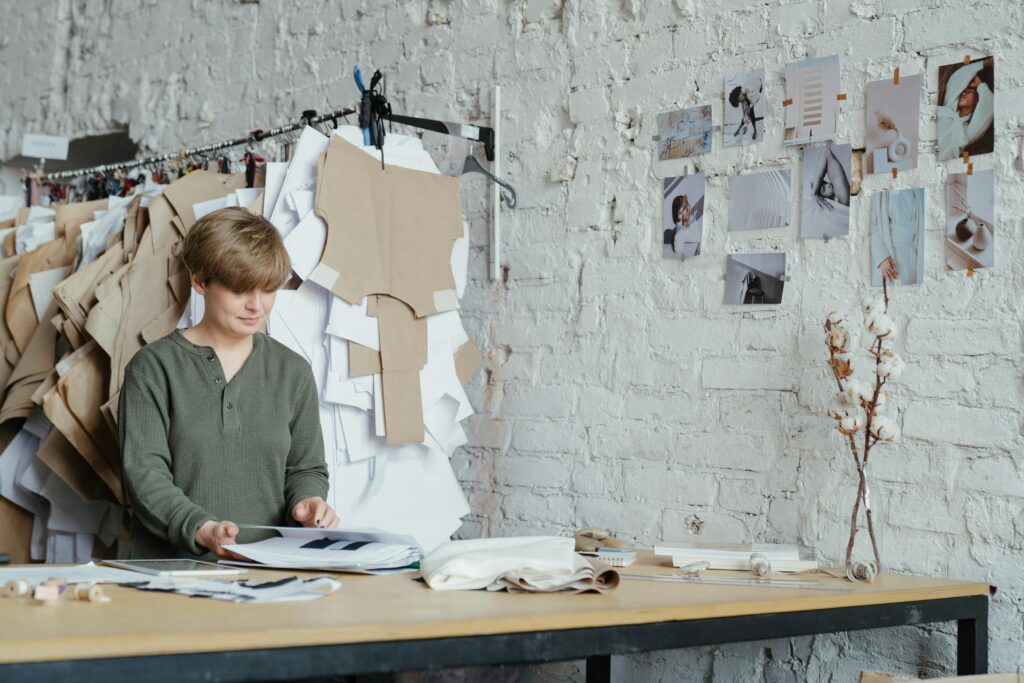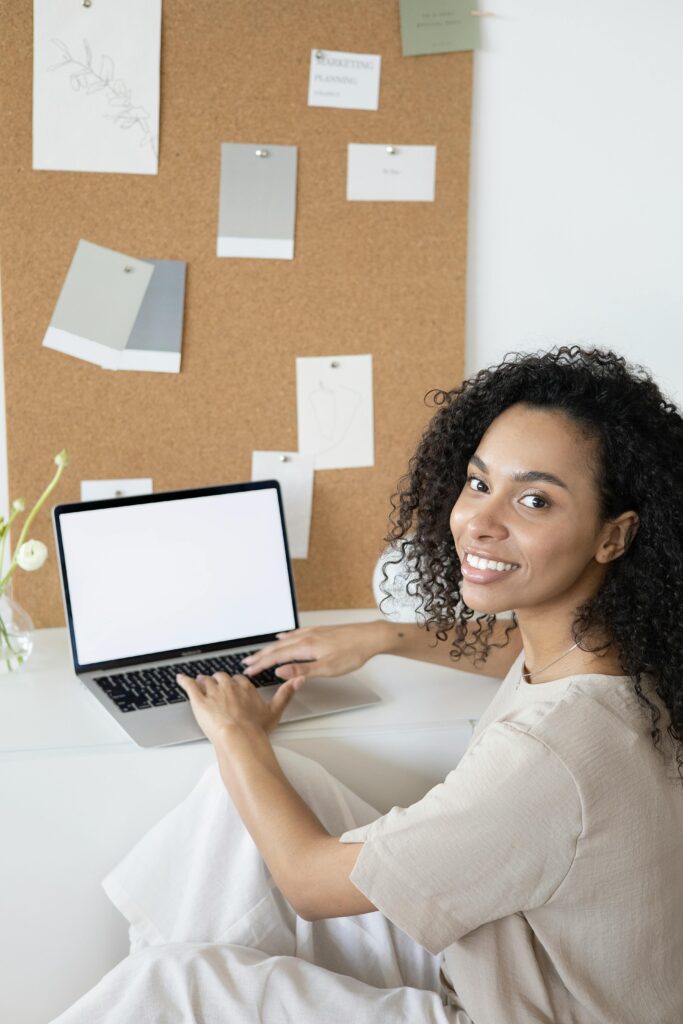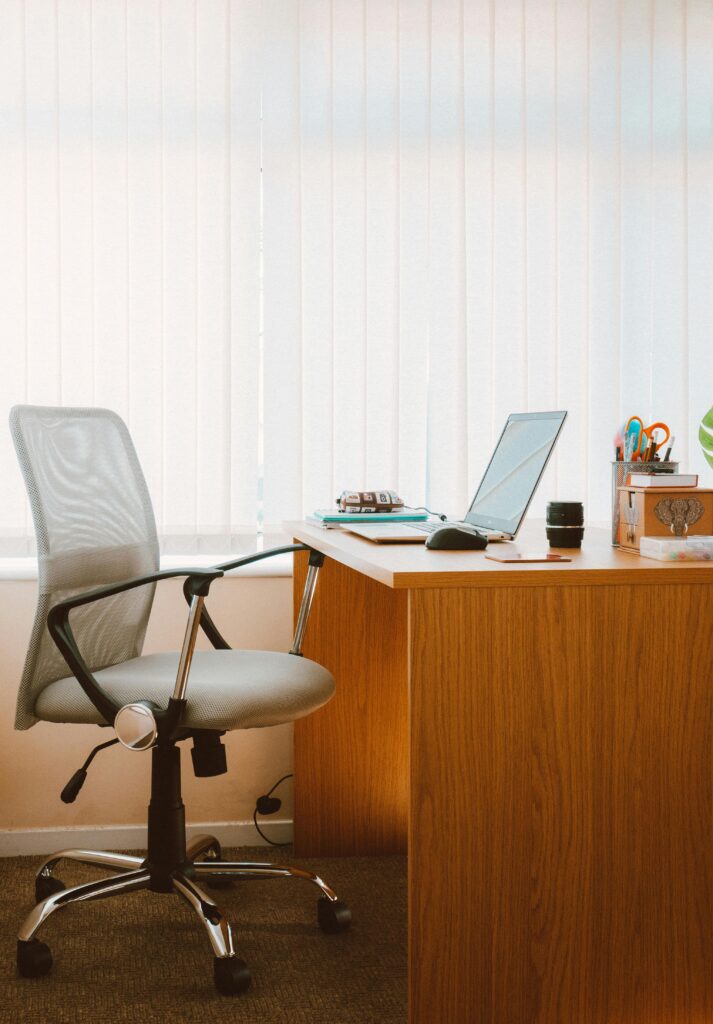Right now, I don’t have a creative workspace.
Last year, I was fortunate enough to buy a house. When I first started obsessively checking Zillow for options, I had dreams of big kitchen islands and marble countertops, but it quickly became clear that those things weren’t in the budget. My spouse and I hunted around for months, until we found a house we loved that was in our ideal location, with gorgeous hardwood floors and a yard for our dogs, that we could actually afford. In fact, it was UNDER budget! The catch? In order to move in, we’d have to renovate the whole thing, floor to ceiling. I’m talking about everything from asbestos mitigation to an all-new kitchen. We made a tentative budget, put an offer on the house, and were equal parts delighted and intimidated when our offer was accepted. It took almost six months from closing to moving in, and as of the time of this blog post, we still do not have a full kitchen (our contractor assures us it will be soon, but we’ll see.) Eventually, when everything is complete, I’m going to have the office of my dreams (which will also double as a guest and storage room) where I can do all of my creative work. But for now, the office is full of boxes, and I do my writing in a little corner of the living room. When I get up each morning to write before work, my dogs demand my attention, I get distracted by the chores that need to be done around the house, and when my husband wakes up and walks through the living room to get his morning coffee, I get sidetracked talking to him.
Why am I telling you all of this?
What I’m trying to say is that I don’t currently have a creative workspace in my home, I actually haven’t had one in over a year, and my art is suffering. I get less work done and I’m more likely to make silly mistakes. I rely on things like meditation and visualizations to stay regulated throughout the day, and it’s a lot harder to practice mindfulness when you have a Miniature Pinscher puppy trying to eat your socks (I’ve been told he’ll grow out of it, but seriously.) I like making my workspace pretty, with plants, candles, crystals, and my trusty tarot cards, but all I have right now is a little side table. I also rely on my white board and bulletin board to map out scenes, work through plot holes, and plan revisions, but there’s not room for those things where I’m working, either.

Maybe you’re like me, and you don’t have a creative workspace to help you thrive. Or maybe you do, but you have no idea how to make it work for you. Maybe you want to set up your office at work to help your workflow, or maybe you want to set up your guest room or a corner of your bedroom to be your creative workspace. Regardless of your goals, I’ve got you covered.
Regardless of what type of art you make, what your resources are, and how much space you actually have, it’s important that you have a workspace that is not only practical but makes you feel comfortable, safe, and like your most creative self. That’s why today I am talking about creative workspaces; how to design one, how to create one, and how to keep tweaking it to suit your needs.
1: Determine what your needs are.
The first step to designing your creative workspace is to determine what your needs are. Maybe you’re a visual artist. Do you work on giant canvases, or do you draw on your iPad? Do you need room for collage materials, or clay, or paint? Or maybe you’re a filmmaker. Do you need room to store your gear? A special spot for storyboarding? A desk to write screenplays? I can’t speak to what your specific needs are, but I can talk you through my own process for designing my future office. I’m a novelist and screenwriter, and this is what I need in a workspace:
- I don’t like to write while sitting at a desk, so I need seating options that work for me. I want somewhere comfortable to sit, so for this space I’ll sit on our guest bed since my office is doubling as our guest space. I also like to be able to walk while I write or work out plot problems, so I’m investing in a walking pad and a riser for my laptop.
- I need to be able to work through my outlines visually, so I need a space for my big bulletin board and white board to hang on the wall.
- I want to be able to easily reference my craft books, so I would like to have at least a small bookcase.
- I don’t do my best work when a space is messy or visually cluttered, so I need to have a good organizational system in place, with storage that doesn’t look messy.
- I like to have candles, plants, crystals, vision boards, and other witchy items in my workspace, so I need a place to display them prominently that won’t make me feel overwhelmed or like I’m just creating clutter.
- I drink an almost pathological amount of tea while I work, so having an electric kettle in the space would be a bonus.
- It’s important to me that my space looks pretty and feels like me.
- A printer would be helpful.
Take a moment and think about your wants and needs for your creative workspace. For a moment, don’t think about limitations or restrictions, just think about what would truly serve you best. Nothing is too frivolous or silly. Jot down everything that would make your workspace function best for you and your needs. Anything and everything that would make your workspace work for you goes on the list, no judgment.

#2: let’s be realistic
I want to go right ahead and say that the fact that I have my own office–even if it also doubles as a guest room–is a massive privilege. If you live in a tiny apartment, or have kids, or roommates, or live with your parents, you’re going to have more limitations than I do. But I don’t want you to think that this means it’s not possible to have a creative workspace that serves you. I’ve known artists who work out of their garage, or sheds in the backyard, a closet, or a small corner of their bedroom. As long as you have a vision and at least a little bit of support, we can make this happen. Here are my limitations I’ve come across when designing my own workspace.
- It’s a shared space. I have a small house, and that means my office is also going to be a guest bedroom, plus we’ll need to store some stuff in there even after the renovation is over. This means I’m giving up a lot of floor space and flexibility by having a queen size bed in there; it’s a small room so that takes up the majority of my space. I also have to give up my small closet to storage, and will have to keep other items tucked away under the bed. There’s still room for my small desk, a bookshelf, and (fingers crossed) my walking pad, but it’s going to be a little cramped. I probably don’t have room for a printer or electric kettle.
- I have major budget limitations. As much as I’d love to get everything I want or need for my office space, the truth is that I just bought and renovated a house, so I don’t exactly have a ton of cash to pour into my creative workspace. Even getting the walking pad is going to make my budget tight, so I can’t go crazy with a ton of plants or candles, and I certainly can’t afford the $700 pink floral chandelier I fell in love with.
- Since we’re still waiting for the rest of the house to be finished, I have timeline constraints; it’s going to be a little while before I get to use that room, so I have to make do with something else in the meantime.
Now that I’ve gone over my limitations, let me take stock of what I have going for me in terms of office design.
- I don’t have to fit everything into one space. If I can’t fit a printer, I can ask my spouse to make room in his office for one. If I can’t make room for a kettle, I can simply take the short walk to the kitchen to make myself a cup of tea. It’s less convenient, sure, but it’s more realistic.
- I have a room with a door that closes. Not being interrupted by my three dogs is going to be a game changer.
- I have some money I can put towards this space. It’s not a high number, but it’s not $0 either, so I can gradually add things I love to the space until it feels just right.
Take a moment to be realistic with yourself. Take a look at the list you made in step one and work through each item, figuring out what is and isn’t possible. Try to solve each issue that comes up. Is it difficult to find a space where your kids don’t interrupt you? Do you not have room for a desk in your bedroom? Really think about each issue and then see if you can find a solution. Sometimes, the issue isn’t with the physical space; sometimes to get some dog-free writing time I have to work around my spouse’s schedule so he can take them to the park or into the backyard to give me some alone time. Try to be creative here, but also know that you probably can’t solve all of your problems. Even the best creative workspace is likely to have some issues or not be 100% perfect. That doesn’t mean you can’t design it to maximize your creativity and productivity!
#3: start designing
Maybe you’re really into interior design like me (seriously, ask me about the tile I picked for my bathroom, I’m begging you) or maybe you literally only care about how a space functions. Either way, you can totally design a creative workspace that works well for you!
The first thing I recommend is taking a look at the physical space you’ll be in. If your workspace is going to be in your bedroom, look at if there’s space to set up a desk, or if not, see if you can rearrange other things to make it happen. If you have your own office, how can you set up furniture in a way that makes sense? Do you have existing furniture you need to use in the space? Will your office, like mine, be serving a dual purpose?
The next step, once you know how you need the space to be set up, is to create a moodboard. If this makes you groan and you just want your space to be fully utilitarian, feel free to skip this step, but it’s one of my personal favorite things. Use Pinterest or Canva to plan out how you want the space to look and feel. My mood board for my future office includes pale pink paint, antique furniture, cute art, and lots and lots of plants. As you work on your moodboard, think about how you want the space to feel: for me it’s feminine, relaxing, and cozy. This has turned into a pale pink office, a butterfly chandelier (that cost MUCH less than $700), using an antique wooden desk that I was given by a family member, mood lighting, and lots of candles and throw blankets.
Once you know what you’re going for, it’s time to start gathering supplies. Maybe you have all your furniture but you want your desk in your bedroom to feel cuter and more functional; something as simple as a lamp from the thrift store, a low-maintenance pothos, and a white board from Staples might do the trick. If you’re starting the space from scratch, I recommend scouring Facebook Marketplace or your local thrift store for low-priced furniture. You can also always hit up spots like Ikea to find furniture that is cute and reasonably priced. I love places like Etsy, thrift stores, or local marketplaces to look for art, and as much as I hate to admit it, I found the most amazing mid century style wall sconces and cozy throw blankets on Amazon.
As you’re planning out your space and gathering materials, keep factors like budget, comfort, and your vision in mind. Think carefully about how you spend your money and what items you bring into your space. If you’re getting a desk chair, make sure you’re thoughtful about ergonomics and what will make your body feel good; I’m a sucker for a cute chair but if I’m spending hours in it every day, I need to make sure it’s not going to make my back hurt. If aesthetics are important to you and you have a little bit of cash, give yourself permission to invest in things like art that makes you feel more creatively inspired. If you find a desk that fits in your budget but doesn’t fit the vibe you’re trying to cultivate, either ditch it or think carefully about what your space would be like with that piece in it. Basically, take your time and don’t bring anything into your creative workspace that doesn’t fit your needs if you can afford to wait a little longer. I always think it’s better to build a space piece by piece than it is to rush into anything that won’t serve you.

#4: keep tweaking
Once you have a functioning space, don’t feel like you’re 100% locked in to your vision of what this space should be or how it should function. It’s entirely possible–likely, even–that once you’re working in the space, you’ll figure out big or small ways it could be better. For example, maybe I’ll get into my long-awaited office and discover that I’m walking away from my desk to make a fresh cup of tea every thirty minutes, which is leading me to get distracted. Maybe that means it’s actually a better idea to have a tea kettle than a bookshelf in my office. If that happens, I’ll just have to be ready to pivot! Or maybe it will be like my office at my job, where I had my desk set up all cute and aesthetic before realizing I actually needed all that space for things like papers and files (before you come at me and say that’s obvious, I need to tell you I was a kindergarten teacher prior to this; I’d never actually had an office before!)
As an artist, you’re always learning more about yourself and your process, and creating a creative workspace is no different. Take data on yourself and see what does and doesn’t work for you, and stay open to tweaking your plan or even pivoting entirely. Your space never needs to be 100% finished; your needs will change, your art will change, and you will change over the lifetime of this creative workspace.
Good luck, and happy designing! I’d love to see a picture of your workspace once it’s done!

Leave a Reply